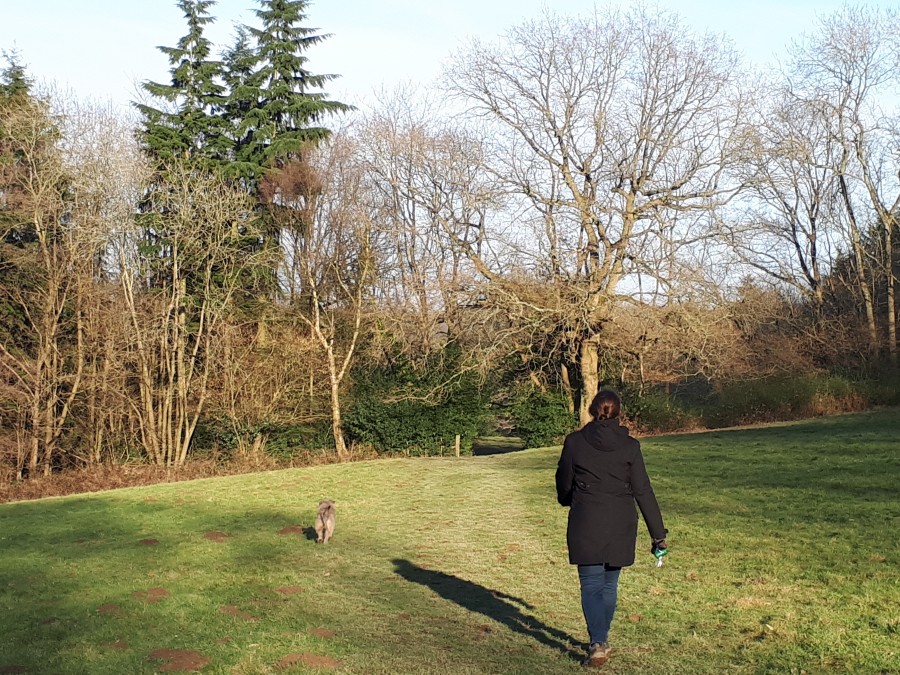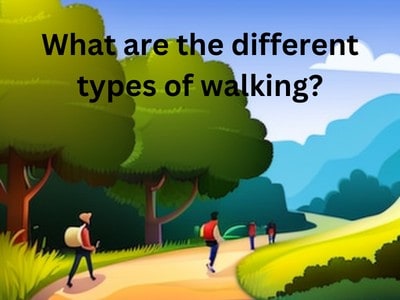Table of Contents
Some links on posts are affiliate links and will earn us a commission from qualifying purchases
Let’s face it, we all walk every day, unless we are bed-ridden of course. But there’s a difference between walking from your front door to the garage, walking round shops at lunchtime, and the kind of walking you see every 4 years when you watch the Olympics.
There are many different types of walking, ranging from an amble, a casual stroll, a steady walk, a brisk walk, power walking, race walking, marathon walking and Nordic walking.
But what do each of these types of walk mean, and should you do all of them? Let’s take a look at what I think they are.
An Amble
When I think of an amble, I have an image in my head of someone shopping. There’s no real purpose, no definite destination to get to quickly, just an amble along, looking at various shops and so on.
Of course, you don’t have to be spending your hard earned money to go on an amble – you can do this at any time. Maybe you have been stuck at your desk in the office for an hour – you know you need to get up and stretch, take 5 minutes break to recharge your batteries, so why not take a short amble to the kitchen to get a glass of water.
A casual stroll
To me a casual stroll is a bit more than an amble, slightly quicker, maybe a bit longer. The kind of walk that you would do at lunchtime if you know that you need to get some fresh air, but you have plenty of time and are not running errands.
This is what I do a lot at lunchtimes. I work in an office and staring at a screen all morning is not the best for me. So in order to rest my mind, I will go for stroll through the High Street window shopping or maybe a walk round the local roads. You will often see me on the phone at the same time, catching up with my other half, Mum, friends.
A steady walk
To me steady walk is where the real work starts to begin. This is where you start to feel like you are doing a little bit of exercise. It’s when you go out to walk with a purpose or a time frame – so a lunchtime walk but running errands counts in this bracket, in my mind.
You know what it’s like when you want to get some jobs done during your lunch break – you need to get to the bank, pop to the supermarket, and drop the dry cleaning in also. You can’t just stroll from one to the other, you will run out of time (unless you get more than the usual hour for lunch). And of course, that’s when seemingly all the retired people, who have all day to do their chores, seem to have the same idea as you and slow down your progress.
A much better way of having a steady walk is when you meet up with a friend for some exercise and chat. It’s so easy to lose contact with friends, so why not suggest this at the weekend with someone you haven’t seen recently, who you know would be like minded and see the benefit of a catch up walk.
A steady walk will be paced at about 3 miles per hour, or a mile every 20 minutes. Of course, we are all different, so don’t think this is set in stone.
A brisk walk
You may find that your friend you have just met up with for a steady walk actually has the same ambitions as you to lose a few pounds, get a bit of exercise, and enjoy some fresh air. They may want to up the ante and suggest that you meet once a week for a brisk walk.
Having this weekly commitment is good – it will ensure you get your trainers on and out the door. The thought that you don’t want to let down your friend is a great motivating factor, even though they may be having the same thoughts.
When you go for a brisk walk you will start to feel a little breathless, although you should still be able to hold down a conversation. It’s probably wise to do a little stretching when you set out, so that you don’t cause yourself any injuries. You want to set off at a pace that is quicker than your steady walk, but one you can keep up for about an hour.

If you don’t have a friend to walk with then don’t worry, you can still do a brisk walk, you just have to motivate yourself to keep going at a quick pace. This may be easier than when you are with a friend, although when on your own it’s all too easy to not get out in the first place.
I remember on Boxing Day I was on my own and had been working all morning. I was desperate to get out for some fresh air after lunch, so took my recycling to the local recycling centre in the supermarket car park. Having done that, and realised it was a nice day, I just set off on a brisk walk round town. I had no plans as such, just kept going out and out each time I got to a new road. Before I knew it I had done 4 miles very quickly, and felt as if I had earned a little reward when I got back.
Power walking
Power walking is becoming more and more popular with people. Similar to a brisk walk, but just a little quicker, and using your arms to propel yourself too. It’s an all over exercise routine!
It’s becoming an alternative to jogging, as people realise the effects of jogging can have on joints and feet. It has been suggested that power walking burns off as many calories as jogging, so it is a great option to take if trying to lose weight.
There’s a bit more into the mechanics involved in power walking. A power walker pushes off each stride from the toes, keeping the back leg straight so that you stay safe and strong. As you step forward your heel lands first, with your back leg starting to lift off from the toes. As you transfer your weight forward you can feel the power in the back leg pushing off.
Arms work like pistons, pumping back and forth with elbows bent at 90 degrees. Using your shoulders you push forwards, raising your arm high, but your hand no no higher than shoulder level. Keeping your elbows tucked in, you should feel as if you are punching the air as you walk.
It’s possible to reach speeds of around 5 miles per hour, or in other words, walking a mile in about 12 minutes.
Race walking
If you have been power walking for a while and have a competitive streak in you, you may want to take up race walking. If so, you will need to make sure you walk on your endurance as well as speed.
If you have seen race walking on the TV when watching the Olympics, you will see that their walking gait is highly exaggerated. There’s a real wobble from side to side – it always makes people laugh, but it can be addictive to watch.
The one rule that you must remember is to ensure that one foot is on the ground at all times, otherwise you will be in danger of earning a warning. Keep doing this and you could easily be disqualified.
Popular race distances are 10k, 20k, even up to 50k or more!
Marathon walking
A marathon is 26.2 miles, and you see many big cities and towns holding one each year. In the UK the biggest is the London Marathon, but other famous ones around the world include Boston, Tokyo, Berlin and Rotterdam. Almost all of the people entering these marathons will be running the full distance.
But more and more people are now walking marathons, with race organisers setting up specific races for walkers, often with themed points of interest. For example, the London Marathon walk at the end of September 2019 passes through 26 different film set locations – if you take part, will you be able to recognise where Bridget Jones, Love Actually and the Harry Potter films were set?
How long will a marathon take to walk, you may ask? Everybody walks at different speeds, but generally speaking a minimum of 6 hours with 8 being more typical. Of course, some will take longer, so it is best to put aside the whole day for your efforts.
Nordic walking
Nordic walking, or as it is sometimes known pole walking, was developed in Scandinavian countries as a way for skiers to train off season. You hold poles which you use to push down on, thus using lots of muscles that may not get worked as hard during normal walking styles mentioned above.
You hold the poles at one end on designed hand grips, pushing down as you walk. It is essential that your poles are the correct length, and they can be used both on hard surfaces such as pavements as well as the more common fields out in the countryside.
Nordic walking is quite often popular amongst more elderly walkers, as they enjoy the stability that the poles offer.
Conclusion – what are the different types of walking?
No matter which of these styles of walking you tend to do more of, I think it is important to mix it up a bit. Don’t always power walk, sometimes let your body recover with a steady walk – your muscles will enjoy the slower pace whilst still getting a workout. But then again, don’t always amble around – start pushing yourself to involve a brisk walk and start to feel the health benefits of getting your heart working a bit harder.
Recent Posts
Which is best? Morning walk vs Evening walk | Pros & Cons for both
Fitting walks in on weekdays into your daily schedule can be a bit of a juggling experience. It is best to try and stick to a particular time, if at all possible, but obviously this is not always...
Many years ago, in my teens, I used to be a runner. I wasn't an elite or even club athlete, but I used to go out plodding round the streets of my home town, and a couple of times a month me and my...


